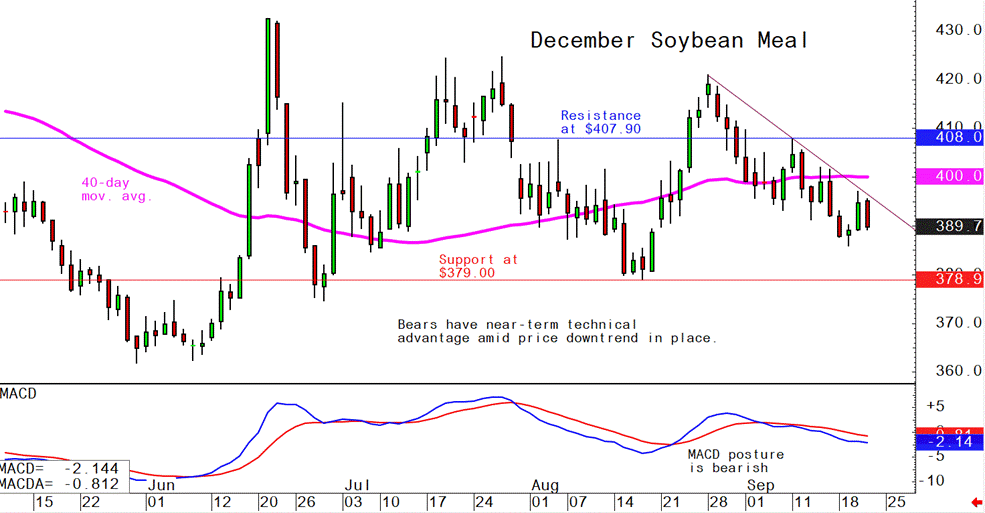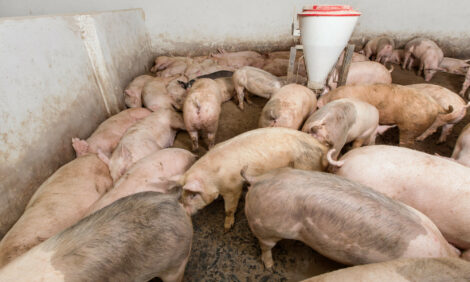



Pig outlook: Lean hog futures bulls keeping price uptrend alive
US pork export sales, Prop 12 & EU annual livestock reportOctober lean hog futures Wednesday hit a seven-week high and prices are in an uptrend on the daily bar chart. That means the path of least resistance for prices in the near term is sideways to higher. The CME lean hog index continues to base above the Sept. 5 low of $86.01, with the quote as of Sept. 18 falling 35 cents to $86.58. The index is expected to rise, with the preliminary quote for Sept. 19 rising 9 cents to $86.67. That would put October futures within $1.00 of the index, which has only happened one other day since May 2023. The sustained buying pressure in futures despite the lack of upward follow-through in the lean hog index shows the bullish short-term bias that traders maintain. Pork cutout staying above the $100.00 will be key in sustained gains across the pork complex.
Weekly USDA export sales for US pork
Pork: Net sales of 30,200 MT for 2023 were up 31 percent from the previous week and 1 percent from the prior 4-week average. Increases primarily for Mexico (13,500 MT, including decreases of 300 MT), South Korea (3,600 MT, including decreases of 300 MT), Canada (3,300 MT, including decreases of 700 MT), China (2,500 MT, including decreases of 200 MT), and Japan (2,100 MT, including decreases of 1,400 MT), were offset by reductions for Nicaragua (200 MT). Net sales of 200 MT for 2024 were reported for Colombia. Exports of 25,600 MT were up 23 percent from the previous week, but down 5 percent from the prior 4-week average. The destinations were primarily to Mexico (9,700 MT), Japan (3,700 MT), China (2,700 MT), South Korea (2,600 MT), and Canada (2,400 MT).
California's Proposition 12 triggers pork price surge and supply disruptions
California's Proposition 12, imposing stringent pork production standards, went into effect on July 1, 2023, causing significant price increases and supply chain disruptions in the state, according to a recent review by Southern Ag Today. The law mandates that uncooked pork sold in California must come from sows kept in pens with at least 24 square feet of space, impacting producers and processors from major hog-producing states.
While a Sacramento County court order allowed non-compliant pork in the supply chain before July 1 to continue being sold in California until December 31, early data from Circana retail-level scanners indicate signs of strain in California's pork market, the article notes. Pork prices have surged, with pork ribs and loin prices witnessing substantial hikes of 25% and 43% in August compared to June, respectively, in California. In contrast, the rest of the U.S. saw lower price increases during the same period.
Alongside rising prices, there has been a notable decline in the volume of pork purchased in California, decreasing by 23% from June to August 2023. This volume is 37% less than the average volume sold in August from 2020-2022.
Of note: The implementation of similar laws in other states, like Massachusetts, adds to the uncertainty surrounding the implications of Proposition 12 for consumers and livestock producers across the United States, particularly in the South.
USDA’s annual European Union livestock report
Swine and Pork – The EU Swine Sector Is Refocusing on the Domestic Market
Plummeting export demand combined with surging feed prices created a piglet production dip in 2022, which started a new swine cycle by causing a price surge for piglets, hogs, and sows during the second half of 2022 through the first half of this year. At the same time, feed prices came down from the peak levels reported during mid-2022. With the current improved profit margins, swine farmers are generally less hesitant to stop production and more eager to keep their stables occupied. The improved profitability is expected to support a temporary rebound of slaughter during the second half of 2023, but not sufficient to balance out the reduced slaughter in the first half of the year. In absolute terms, the most significant cuts are expected in almost all main pork producing EU MSs. In line with declining slaughter, EU pork production is forecast to decrease in 2023 and 2024. Because of the absence of a full recovery of Chinese demand due to the economic slowdown, the EU swine sector attempts to diversify exports to other third countries, but none of the destinations, not even combined, were able to fill the gap left by China. The sector also faces dwindling demand at the domestic market. EU consumers show a preference for poultry over pork based on health considerations, ease of preparation, and the relatively lower price. Through restructuring, the sector strives to bring the supply back in line with traditional domestic and export demand. Leading companies in northern and southern Europe plan to focus less on quantity and more on quality, profitability, and European consumer preference, furthering the concentration and integration of the sector.
Pork: The Lost Exports to China Have Not Been Replaced by Other Destinations.
During the first half of 2023, EU pork exports decreased by 21 percent, with reductions reported for all top-12 export destinations except the United Kingdom (mainly fresh boneless pork, and bacon) and Malaysia (mainly bellies). Exports to the United Kingdom, increased slightly (3.4 percent) due to the declining domestic supply. To put the current total EU export level in perspective, the volume equals the level reported before the ASF outbreaks in China. The shortage of pork in China pushed EU exports to a record of 5.2 MMT CWE in 2020, after which Chinese demand for pork imports fell in 2021 due to the COVID pandemic followed by an economic slowdown and a partial recovery of domestic pork production (see graph above). With the absence of a full recovery of Chinese demand, the EU swine sector attempted to diversify exports to other third countries, but none of the destinations, not even combined, were able to fill the gap left by China. In 2022, Spain’s pork exports grew in Asian markets such as Japan, South Korea, the Philippines, and Taiwan which compensated for only for 50 percent of the reduction in sales to China.
EU Producers Attempt to Diversify Exports to Other Markets.
The Spanish pork industry estimates that in 2023, Spanish pork sales to non-EU markets will continue to decline in volume. The reason given is similar as reported by Danish Crown, namely the increase in EU domestic pork prices is reducing competitiveness on the global market. At the same time are producers, veterinary authorities, and governments trying to open new markets. The Portuguese sector expects to finalize the protocols to export pork to the Philippines by the end of 2023 and is also working to open Singapore and Vietnam. Germany concluded a regionalization agreement with South Korea and Ukraine and is attempting to open other markets which were closed due to ASF outbreaks.
China’s pork exports slowed in August
China imported 110,000 MT of pork during August, down 10,000 MT (8.3%) from July and 21% less than last year. Through the first eight months of 2023, China imported 1.17 MMT of pork, up 9.6% from the same period last year.
USDA monthly livestock outlook
Pork/Hogs: Continued lower dressed weights offset higher August slaughter numbers to reduce pork production fractionally compared with a year earlier. Third-quarter pork production is expected to be about 6.4 billion pounds, 1.8 percent lower than a year ago. Hog prices for the quarter are forecast at $69 per cwt on lackluster hog and pork demand. Fourth-quarter pork production is expected to increase 2.3 percent over the same period a year ago, with hog prices more than 7 percent lower, to $59 per cwt, compared with the same period of 2022. July pork exports increased more than 4 percent above same-period volumes of a year ago, although a higher-valued US dollar exchange rate and foreign expectations of upcoming seasonally low pork prices likely cut into US market share across Asia. Total 2023 exports are forecast at 6.8 billion pounds, up 7.2 percent from last year.
The next week’s likely high-low price trading ranges:
October lean hog futures--$81.875 to $88.00 and with a sideways-higher bias
December soybean meal futures--$379.00 to $405.00, and with a sideways-lower bias
December corn futures--$4.67 3/4 to $4.90 and a sideways bias
Latest analytical daily charts lean hog, soybean meal and corn futures












